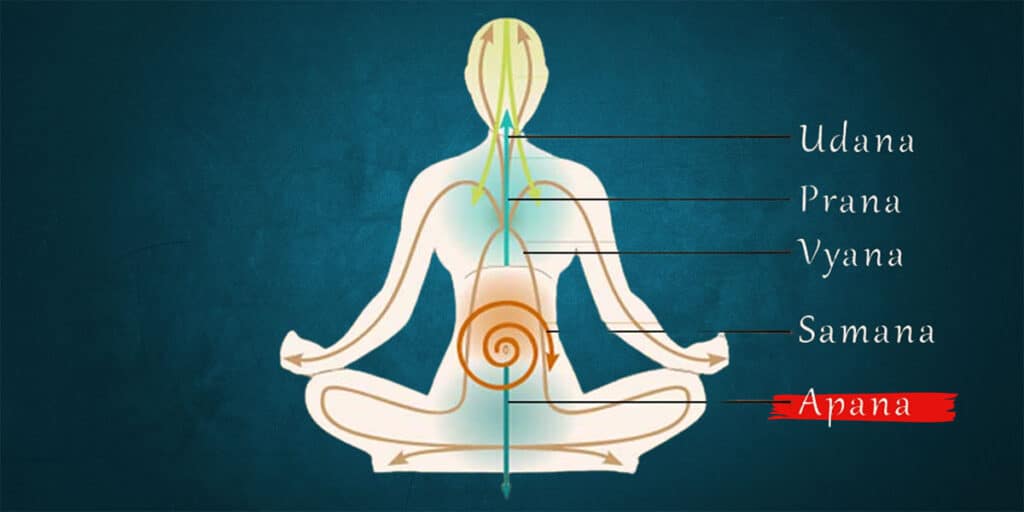Understanding Apāna Vāyu – The Second of the Pancha Pranas
by Hardik Mehta

In yogic science, the subtle energy that governs all bodily and mental functions is known as Prana. According to ancient yogic texts, Prana is divided into five major subdivisions called the Pancha Pranas — Prāna, Apāna, Samāna, Udāna, and Vyāna. These five vital airs or energies sustain our life and regulate specific physiological and psychological functions.
In this blog, we’ll focus on Apāna Vāyu, the second of the Pancha Pranas, its significance in our everyday life, how to balance it, and why understanding it is vital for spiritual and physical well-being.
What is Apāna Vāyu?
Apāna Vāyu represents the vital downward-moving force within the body that oversees processes of elimination and grounding. Located in the lower abdominal region, it influences the functioning of the pelvis, large intestine, kidneys, bladder, and reproductive system. The Sanskrit word “Apāna” means “that which exits” or “moves downward,” aptly capturing its role in expelling waste from the body, such as urine, stool, gas, and other byproducts, thereby maintaining internal balance and stability.
Whereas Prāna Vāyu brings in energy, Apāna Vāyu is the counterpart that eliminates what is no longer needed — physically, emotionally, and energetically.
Location and Direction of Apāna Vāyu
Apāna Vāyu is situated in the pelvic region, beneath the navel, and flows in a descending and outward direction. This energy current is closely connected with the Muladhara (root) chakra and the Swadhisthana (sacral) chakra, reinforcing its role in stability, security, and elimination.
Functions of Apāna Vāyu
- Excretion and Detoxification
Apāna governs the optimal operation of the kidneys and large intestine, facilitating the smooth and efficient elimination of waste from the body. When balanced, it promotes a healthy digestive and urinary system, preventing constipation, bloating, or kidney issues.
- Reproductive Health
Apāna governs the reproductive organs. It plays a key role in menstruation, ovulation, ejaculation, and childbirth. Disruption in Apāna energy can lead to infertility, menstrual irregularities, or complications during labour.
- Grounding and Stability
This Vāyu keeps us grounded — physically and emotionally. When Apāna is balanced, we feel stable, rooted, calm, and mentally clear. When it’s imbalanced, we may feel spaced out, anxious, or fearful.
- Energy Elimination
Just as it eliminates physical waste, Apāna Vāyu also helps clear negative emotions, old habits, and limiting beliefs. It assists in releasing energetic blocks that hinder personal growth and spiritual evolution.
Symptoms of Imbalanced Apāna Vāyu
When Apāna Vāyu is out of balance, it may manifest in various ways:
- Constipation or diarrhoea
- Menstrual disorders
- Fatigue or lethargy
- Depression or anxiety
- Sexual dysfunction
- Haemorrhoids or urinary tract issues
- Feeling ungrounded or disconnected
How to Balance Apāna Vāyu
Bringing awareness to Apāna Vāyu can help balance this vital force. Here are some effective techniques you can incorporate to harmonise Apāna Vāyu:
- Yoga Asanas for Apāna
Postures that activate and open the hips, pelvis, and lower abdomen are ideal.
- Malasana (Garland Pose)
- Baddha Konasana (Bound Angle Pose)
- Paschimottanasana (Seated Forward Bend)
- Apanasana (Knees-to-Chest Pose)
- Squats and lunges
These postures help stimulate elimination and bring grounding energy into the body.
- Pranayama (Breathwork)
- Nadi Shodhana (Alternate Nostril Breathing): Helps balance both Prāna and Apāna Vāyus.
- Bhramari (Humming Bee Breath): Calms the nervous system and clears mental clutter.
- Bandhas (Energy Locks)
- Mula Bandha (Root Lock) directly engages the region governed by Apāna. It improves control and redirection of the downward-moving energy for higher spiritual practice.
- Meditation & Mantras
Meditating on the Muladhara Chakra with grounding affirmations like “I am safe, I am grounded” can help stabilize Apāna Vāyu.
Chanting LAM (the seed sound of the root chakra) during meditation is also highly effective.
- Diet and Lifestyle
- Eat grounding foods like root vegetables, whole grains, and lentils.
- Follow a consistent daily routine.
- Get enough sleep and avoid overstimulation.
- Avoid excessive movement or stress that can deplete Apāna.
Spiritual Importance of Apāna Vāyu
Apāna Vāyu is not just about bodily elimination; it holds the key to spiritual transformation. In yogic alchemy, when Prāna and Apāna unite at the navel centre through breath control and bandhas, the dormant spiritual energy (Kundalini) awakens.
This process can only happen when Apāna is strong and steady. Thus, Apāna is foundational for deepening meditation, achieving stillness, and progressing toward self-realization.
Apāna and Emotional Detox
On an emotional level, Apāna Vāyu supports the release of deeply held fears, guilt, past regrets, and emotional wounds. When this vital energy becomes sluggish or blocked, we may find ourselves clinging to the past, hindering personal evolution. A healthy flow of Apāna empowers us to let go with ease, embrace forgiveness, and step forward with clarity and openness.
Integrating Apāna Vāyu in Daily Life
- Begin your day with deep breaths and a grounding affirmation.
- Practice yoga asanas that open your pelvic region.
- Stay hydrated and eat fibre-rich meals.
- Walk barefoot on natural ground to stay connected to the Earth.
- Spend a few minutes in silent meditation focusing on your root chakra.
Why Study Pancha Pranas at Sayujya Yoga?
Understanding the Pancha Pranas, especially Apāna Vāyu, requires more than theoretical knowledge. It demands guided practice, introspection, and the right learning environment. This is where Sayujya Yoga excels.
About Sayujya Yoga’s 200 Hours TTC Program
Sayujya Yoga, located in Mumbai, India, is one of the most revered yoga institutes for learning traditional yogic wisdom with a contemporary approach. Their 200 Hours Yoga Teacher Training Course (TTC) is a life-changing journey that covers:
- Deep understanding of Pancha Pranas and their practical applications
- Asana, Pranayama, and Meditation rooted in ancient texts
- Yogic philosophy, anatomy, and teaching methodology
- Detoxification and purification techniques
- Personalised attention and experiential learning
Whether you’re looking to become a certified yoga teacher or seeking inner transformation, Sayujya Yoga’s TTC program offers unmatched depth, authenticity, and spiritual enrichment.
Why Choose Sayujya Yoga in Mumbai?
- Experienced and certified instructors
- Authentic teachings with modern relevance
- Flexible batch timings and support
- Peaceful, vibrant, and inclusive learning atmosphere
Recognised by Yoga Alliance International
If you are ready to deepen your yoga practice, understand your subtle body, and evolve as a yogi, Sayujya Yoga is your destination. Join the 200 Hours TTC and experience yoga as it was meant to be — pure, powerful, and transformative.
About the Author

Hardik Mehta
Hardik is an E-RYT 500 & YACEP (Yoga Alliance Continuing Education Provider), Yoga Alliance, USA. He has been practicing yoga for the last 9 years. Prior to finding his true calling in Yoga, he was working with various corporates for 12 years in the Retail and eCommerce sector.
